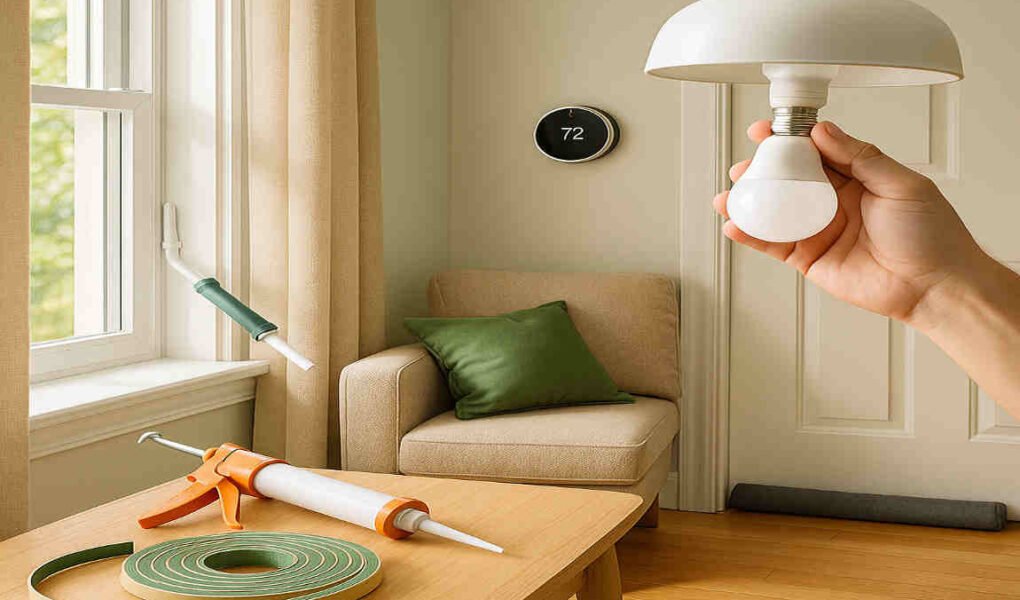Improving your home’s efficiency doesn’t require a huge budget or a full renovation. In fact, some of the smartest upgrades are surprisingly low-cost and offer significant returns over time. Whether you’re hoping to cut your utility bills, make your living space more comfortable, or increase your property value, there are plenty of simple, affordable ways to do it. This guide breaks down practical strategies to help you get more from your home without draining your wallet. These aren’t gimmicks—they’re proven tips for anyone who wants to live smarter, save money, and make their home work better.
Weatherstripping and Sealing Leaks
Gaps around doors and windows can quietly drain your energy budget. Every small crack lets your heated or cooled air escape, forcing your HVAC system to work harder. A few dollars’ worth of weatherstripping or caulk can stop the leak and bring immediate benefits. You’ll notice a difference in temperature consistency and even noise reduction. Walk through your home on a windy day and feel for drafts. Focus on doors, windows, and outlets. This simple fix not only improves comfort but also reduces utility costs month after month. It’s a small effort with a big reward and an ideal first step.
Smart Strategies for Cooling
Air conditioning doesn’t have to be expensive. Strategic use can cut costs without sacrificing comfort. Keep blinds or curtains closed during the hottest parts of the day to block heat. Use ceiling fans to circulate air more effectively, which can make a room feel cooler without lowering the thermostat. Regular maintenance matters, too—clean or replace filters monthly to keep airflow strong and systems efficient. If you’re wondering how to improve AC efficiency, look at insulation, duct sealing, and zoning systems. These small upgrades make a big difference, especially during peak summer months when cooling bills tend to skyrocket.
Lighting the Efficient Way
Lighting is one of the easiest and most overlooked ways to save energy. Swapping out old incandescent bulbs for LEDs instantly reduces power use and lasts much longer. LEDs consume up to 80% less electricity and generate less heat, helping you keep your home cooler. Focus on frequently used fixtures first—kitchen, living room, bathroom. You can also install dimmer switches and motion sensors for even more control and savings. Natural light is another free resource—rearranging furniture to maximize sunlight during the day cuts down on the need for artificial lighting. Efficiency isn’t just about tech—it’s also about smart habits.
Upgrade Your Thermostat
A programmable or smart thermostat allows you to fine-tune your climate control and avoid wasting energy. You can set it to automatically reduce heating or cooling when you’re away or asleep. Even a basic programmable model can save you around 10% a year on heating and cooling bills. Smart thermostats take it further by learning your schedule, adjusting settings based on behavior, and allowing remote control from your phone. These upgrades often pay for themselves within the first year. Installation is usually straightforward, and many utility companies offer rebates that make the investment even more affordable.
Low-Flow Plumbing Fixtures
Water bills often sneak up on homeowners, especially during warmer months or in larger households. One cost-effective solution is replacing standard faucets, showerheads, and toilets with low-flow versions. These fixtures use significantly less water without compromising performance. A low-flow showerhead, for instance, can cut water use in half while still providing a strong, satisfying spray. In kitchens and bathrooms, aerators can also reduce flow without reducing pressure. You’ll not only lower your water bill but also reduce the energy needed to heat water. It’s a dual win—less waste, lower costs—and it all starts with a few quick, inexpensive swaps.
Insulation That Makes a Difference
Many homeowners assume insulation is only for cold climates, but it’s essential for keeping heat out during summer as well. If your home lacks proper insulation, your HVAC system has to work overtime. That means higher energy bills and more wear on your equipment. Focus on attics, crawl spaces, and walls—places where heat and cool air often escape. You don’t need a complete overhaul to see results. Adding batt or blown-in insulation in key areas can reduce energy loss dramatically. For a DIY-friendly option, consider sealing around recessed lighting or attic hatches. Small fixes deliver big returns year-round.
Appliance Efficiency Upgrades
Your older appliances could be quietly draining energy behind the scenes. Even if they still function well, they may use far more electricity and water than newer models. Focus on high-impact appliances like refrigerators, dishwashers, and washing machines. When it’s time to replace them, look for ENERGY STAR® certified options, which meet strict efficiency standards. If new appliances aren’t in the budget right now, try optimizing what you have. Avoid running half-full loads, clean lint filters in dryers, and unplug small appliances when not in use. With better usage habits and smart timing, even older appliances can perform more efficiently.
Landscaping for Climate Control
Your yard can do more than just look nice—it can help regulate your home’s temperature. Planting shade trees on the sunniest sides of your home reduces cooling needs by blocking direct sunlight. In winter, evergreen windbreaks reduce wind chill and heat loss. Strategic placement of shrubs or vines along exterior walls can also insulate your home naturally. Ground cover plants near your foundation prevent heat from radiating upward, helping your home stay cooler. Native plants require less water and maintenance, making your landscaping upgrades even more cost-effective. With thoughtful planting, your outdoor space can actively support indoor comfort.
You don’t need to spend a fortune to make your home more efficient. By focusing on small, affordable upgrades and smarter usage habits, you’ll see real savings and a more comfortable living space. These changes reduce your utility bills, extend the life of your appliances, and lower your environmental footprint. Whether it’s sealing a draft, planting a tree, or swapping a lightbulb, every step adds up. Start with one improvement, and build momentum. With consistent effort and strategic decisions, you’ll transform your home into a cost-effective, energy-smart space—without stretching your budget. It’s practical, it’s doable, and it truly pays off.
You may aslo read (home space saving ideas to make your life more efficient).




